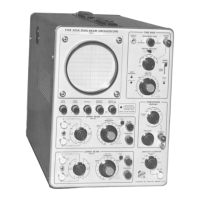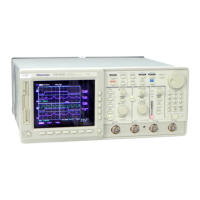Operating Instructions— Type 544/RM544
CAUTION
A MAXIMUM INPUT OF ± 30 VOLTS MUST NOT
BE EXCEEDED IN THE EXTERNAL TRIGGER
POSITION.
HORIZ INPUT Jack for applying external horizontal sig
nal when the HORIZONTAL DISPLAY
switch is set to EXT.
4- GATE OUT Supplies a 20-30 volt square-wave pulse
when the time base is operating. Pulse
duration is approximately 10.5X the set
ting of the TIME/CM switch when the
VARIABLE control is set to CALIBRATED.
SWEEP OUT
VERT SIG OUT
Chopped
Blanking Switch
(rear panel)
External Single
Sweep Reset
(rear panel)
Supplies the sawtooth voltage of time base.
Peak amplitude is about +100 volts.
Vertical signal output connector. Output
amplitude is approximately 0.4 volt per
centimeter of deflection.
Provides blanking of between-channel
switching transients when using multi-chan
nel plug-in units in the chopped mode.
Allows remote control of resetting in single
sweep operation. See Section 1 for reset
step or pulse requirements.
Selecting Trigger Coupling
Three means of trigger coupling are available with the
COUPLING switch. The different coupling positions permit
you to accept or reject certain frequency components of the
triggering signal.
With the COUPLING switch set at DC, the time base can
be triggered with all frequency components of the triggering
signal within the trigger amplifier passband, including slowly
changing dc levels.
With the COUPLING switch set at AC, the dc component
of the triggering signal is blocked. Also, low-frequency sig
nals below about 30 cps are attenuated.
With the COUPLING switch set at AC LF REJ, dc and low-
frequency signals (below about 1.5 kc) are rejected or attenu
ated. Thus, the trigger circuit will respond best to the higher-
frequency components of the triggering signal.
In general, use AC coupling. However, it will be necessary
to use DC coupling for very low-frequency signals. When
line-frequency hum is mixed with the triggering signal, it is
best to use AC LF REJ coupling so that triggering takes place
only on the signal of interest (if the signal of interest con
tains frequency components above about 1.5 kc).
OPERATION
Sweep Triggering
Proper sweep triggering is essential for a stable presenta
tion of an input signal. For a stable display, the sweep must
be triggered at the same time relative to the displayed sig
nal. Thus, the sweep must be triggered by the input signal
or by some external signal that has a fixed time relationship
with the displayed signal. The external trigger signal must be
the same frequency or a submultiple of the input signal.
Selecting the Trigger Source
The SOURCE switch selects one of a variety of possible
triggering signals. For most applications, the sweep can be
triggered internally from the displayed signal. This occurs
with the SOURCE switch set at NORM.
The PLUG-IN position is for plug-in units that will supply
a single-channel triggering signal through pin 5 of the inter
connecting plug, such as the Tektronix Type 1A1 Dual-Trace
Plug-In Unit. This position is useful when operating the plug
in unit in dual-trace chopped-mode operation since the trig
gering signal is the same as the applied signal and is fiee
from any between-channel switching transients.
The LINE position of the SOURCE switch internally connects
a line-frequency signal to the triggering input. Line trigger
ing is useful whenever the input signal is frequency-related
to the line frequency.
To trigger the time base from an external signal, set the
SOURCE switch to EXT and connect the trigger signal to the
TRIGGER INPUT connector. External triggering is often used
when signal tracing in amplifiers, phase-shift networks, and
wave shaping circuits. The signal from a single point in the
circuit can be used as the external trigger signal. With this
arrangement, it is possible to observe the shaping and/or
amplification of a signal at various points through the cirtuit
without resetting the triggering controls for each new display.
The AC LF REJ position is also useful when triggering inter
nally from multitrace plug-in units operated in the alternate
dual-trace mode (unless the plug-in unit is a Type 1A1 and
the SOURCE switch is set to PLUG-IN). AC LF REJ coupling
has a faster recovery time when subjected to the alternate dc
levels from the multi-trace plug-in unit.
Selecting Trigger Slope
The trigger SLOPE switch determines whether the trigger
ing circuit responds on the rising (+ setting) or the falling
(— setting) portion of the triggering signal. When several
cycles of a signal appear in the display, the setting of the
SLOPE switch will probably be unimportant. However, if
you wish to look at only a certain portion of a cycle, the
SLOPE switch will help start the display on the desired slope
of the input signal. Fig. 2-1 illustrates the effect of both the
SLOPE and TRIGGERING LEVEL controls.
Selecting Trigger Mode
The automatic stability mode is generally more convenient.
With the MODE switch set to AUTO STABILITY, proper trig
gering takes place after setting the TRIGGERING LEVEL con
trol. When the triggering signal is removed, the time-base
circuit automatically free runs and presents a reference
display.
The TRIG position of the MODE switch should be used if
the trigger signal has a very low repetition rate (below
about 20 cps).
Setting Triggering Level
The TRIGGERING LEVEL control determines the amplitude
point on the signal where triggering occurs.
<D
2-2

